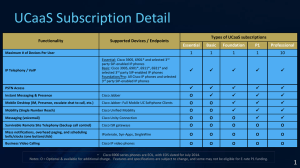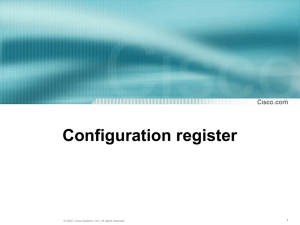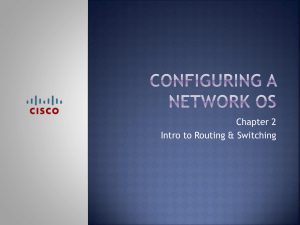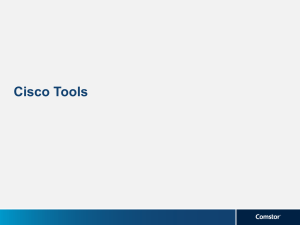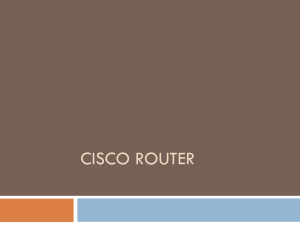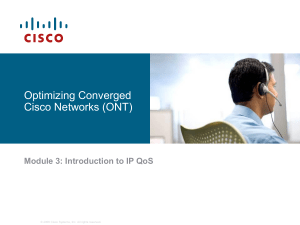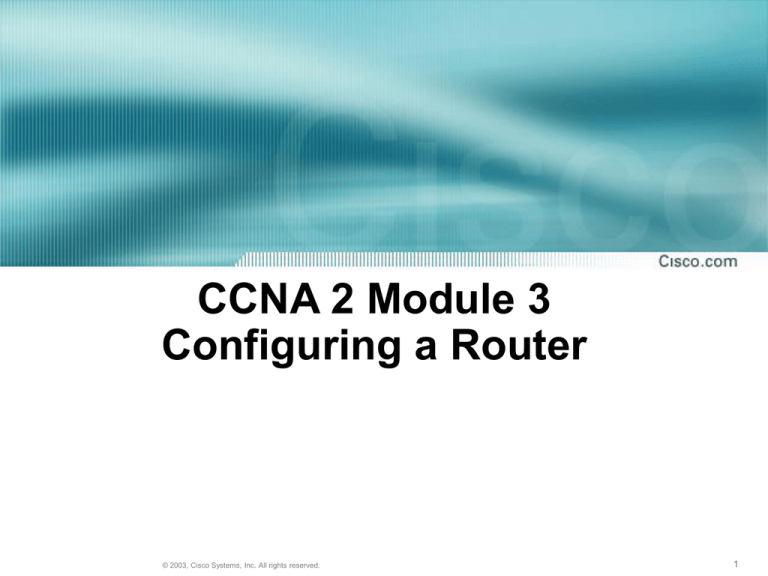
CCNA 2 Module 3
Configuring a Router
© 2003, Cisco Systems, Inc. All rights reserved.
1
Objectives
• Upon completion of this module, the
student will be able to perform tasks
related to the following:
• Configuring a router
• Finishing the configuration
© 2003, Cisco Systems, Inc. All rights reserved.
2
Overview
• Name a router
• Set passwords
• Examine show commands
• Configure a serial interface
• Configure an Ethernet interface
• Execute changes to a router
• Save changes to a router
• Configure an interface description
• Configure a message-of-the-day banner
• Configure host tables
• Understand the importance of backups and documentation
© 2003, Cisco Systems, Inc. All rights reserved.
3
Command-Line Interface
Command Modes
© 2003, Cisco Systems, Inc. All rights reserved.
4
Configuring a Router Name
A router should be given a unique name as one
of the first configuration tasks. This task is
accomplished in global configuration mode
using the following commands:
Router(config)#hostname Tokyo
Tokyo(config)#
© 2003, Cisco Systems, Inc. All rights reserved.
5
Configuring Router Passwords
The service passwordencryption command
applies a weak encryption
to all unencrypted
passwords.
© 2003, Cisco Systems, Inc. All rights reserved.
6
Examining the show Commands
• There are many show commands that you
can use to examine the contents of files in the
router and for troubleshooting.
• In both privileged EXEC and user EXEC
modes, the command show ? provides a
list of available show commands.
© 2003, Cisco Systems, Inc. All rights reserved.
7
Examining the show Commands
Continued
• show interfaces – Displays all the statistics for all the
interfaces on the router
• show clock – Shows the time set in the router
• show hosts – Displays a cached list of host names and
addresses
• show users – Displays all users who are connected to
the router
• show history – Displays a history of commands that
have been entered
• show flash – Displays information about flash memory
and what IOS files are stored there
© 2003, Cisco Systems, Inc. All rights reserved.
8
Examining the show Commands
Continued
• show version – Displays information about the router
and the IOS that is running in RAM
• show ARP – Displays the ARP table of the router
• show protocol – Displays the global and interface
specific status of any configured Layer 3 protocols
• show startup-configuration – Displays the
saved configuration located in NVRAM
• show running-configuration – Displays the
configuration currently running in RAM
© 2003, Cisco Systems, Inc. All rights reserved.
9
show version Command Example
© 2003, Cisco Systems, Inc. All rights reserved.
10
Serial Interface
Configuration Commands
© 2003, Cisco Systems, Inc. All rights reserved.
11
Configuring an Ethernet Interface
To configure an Ethernet interface follow these steps:
• Enter global configuration mode.
• Enter interface configuration mode.
• Specify the interface address and subnet mask.
• Enable the interface.
© 2003, Cisco Systems, Inc. All rights reserved.
12
Configuring an Serial Interface
To configure an Ethernet interface follow these
steps:
• Enter global configuration mode.
• Enter interface configuration mode.
• Specify the interface address and subnet
mask.
• Set clock rate if a DCE cable is connected.
Skip this step if a DTE cable is connected.
• Enable the interface.
© 2003, Cisco Systems, Inc. All rights reserved.
13
Configuring Interface Descriptions
• An interface description should be used to identify important
information such as a distant router, a circuit number, or a
specific network segment.
• A description of an interface can help a network user
remember specific information about the interface, such as
what network the interface services.
© 2003, Cisco Systems, Inc. All rights reserved.
14
Interface Description
© 2003, Cisco Systems, Inc. All rights reserved.
15
Login Banners
© 2003, Cisco Systems, Inc. All rights reserved.
16
Login Banners (MOTD)
• A login banner is a message that is displayed at login.
• Login banners can be used to convey messages that
affect all network users, such as scheduled system
shutdowns.
• Login banners can be seen by anyone.
• “Welcome” is an invitation for anyone to enter a router
and is probably not an appropriate message.
• A login banner should warn users not to attempt login
unless they are authorized.
• A message such as “This is a secure system,
authorized access only!” informs unwanted visitors that
any further intrusion is illegal.
© 2003, Cisco Systems, Inc. All rights reserved.
17
Configuring Message-of-the-Day
(MOTD)
• Enter global configuration mode to configure a messageof-the-day (MOTD) banner.
• Use the banner motd command, followed by a space
and a delimiting character, such as the pound sign (#).
Add a message-of-the-day (MOTD) followed by a space
and the delimiting character again
© 2003, Cisco Systems, Inc. All rights reserved.
18
Host Name Resolutions
• Host name resolution is the process that a
computer system uses to associate a host
name with an IP address.
• Host names, unlike DNS names, are
significant only on the router on which they
are configured.
© 2003, Cisco Systems, Inc. All rights reserved.
19
Configuring Host Tables
© 2003, Cisco Systems, Inc. All rights reserved.
20
Configuring Host Tables
Continued
© 2003, Cisco Systems, Inc. All rights reserved.
21
Configuration Backup and
Documentation
© 2003, Cisco Systems, Inc. All rights reserved.
22
Using the copy running-config
tftp Command
© 2003, Cisco Systems, Inc. All rights reserved.
23
Using the copy tftp running-config
Command
© 2003, Cisco Systems, Inc. All rights reserved.
24
Summary
© 2003, Cisco Systems, Inc. All rights reserved.
25





